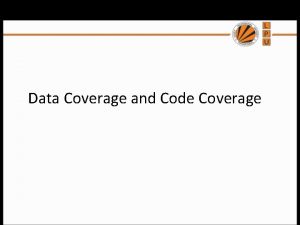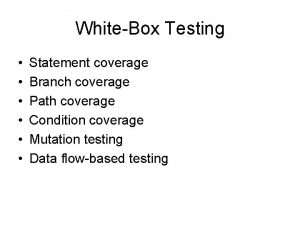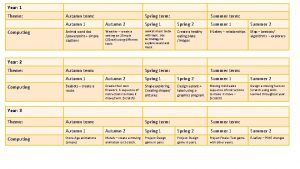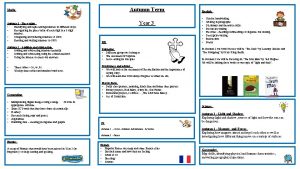English Coverage Year 4 Autumn Term Year Group







- Slides: 7


English Coverage: Year 4 Autumn Term Year Group: 4 Core Text: The Incredible Book Eating Boy – Oliver Jeffers Unit Written Outcomes: Retell the story from Henry’s point of view Explanation text – How do we digest our food? Topic Links: Science – Digestive System Possible Application: Recount - book recommendation Instructions – How to make a healthy snack Guided Reading Possibilities: Range of different books chosen by children in response to text. Other books by Oliver Jeffers Spoken Language Reading Writing - Composition Writing – Grammar and Vocabulary Objectives Give an opinion with a reason. Listen to others’ opinions. Use Standard English to give an opinion. Recite/perform own compositions. Objectives Discuss range of narrative stories and consider differences and similarities. Understand that these have different plot patterns and they develop in different ways. Identify any words that are unfamiliar. Discuss the meaning of words identified. Check or find the meaning of unfamiliar words. Understand that a writer wants the reader to respond in a certain way. Find where the writer has written to make the reader respond in a certain way and explain how. Compare with own and others’ personal response. Empathise with a character and explain how characters’ actions can tell the reader about their thoughts, feelings and motives. Identify the main idea and the message it may have. Recognise and name different types of poems. Know that words and language in poems create effects. Explain the effect created by the poet’s choice of words and language. Use the organisation and layout of a book to find specific information. Objectives Know that the opening of a narrative engages and informs the reader. Draft an opening of a narrative. Evaluate the effectiveness of the opening in giving sufficient information to engage and interest the reader. Make careful choices about the vocabulary to be used throughout. Annotate plan with chosen vocabulary. Develop ideas and vocabulary about characters: What they do, how they behave, what they say Know that the plot of a narrative can be structured differently according to the kind of story. Identify the plot structure. Understand that paragraphs structure a story. Plan paragraphs. Know that the ending of a narrative needs to relate to the beginning. Identify and consider ways in which writers end stories. Plan ending of the narrative. Know that a non-narrative text needs a series of logical points leading to a closing. Know that each point is developed into a paragraph. Know that the opening sentence (topic sentence) introduces the point. Organise material to form paragraphs. Plan an opening and a closing appropriate to the text type. Objectives Know that a noun phrase can be expanded by adjective/s. Understand that a prepositional phrase can do the job of an adverbial phrase (telling the reader how when or where). Understand that a prepositional phrase can do the job of an adjectival phrase (telling the reader more about the noun). Develop noun phrases expanded before and after the noun. Evaluate their effectiveness in painting a picture in words for the reader. Know the difference between singular and plural nouns and how they are formed. Identify the difference – ‘s and s’ Recognise the use of ‘s in the irregular plural nouns. Use apostrophes for possession correctly in own writing Use inverted commas for direct speech. Include punctuation inside the inverted commas. Use the comma to mark the reporting clause in direct speech in writing. Use direct speech in writing to show character. Use a fronted adverbial to show how, when or something happened. Add fronted adverbials to sentences, marking their boundary with a comma. Choose when to use a how, when or where fronted adverbial. © Focus Education UK Ltd 2

Year Group: 4 Core text: The Pied Piper by Robert Browning Unit Written Outcomes: Rewrite story with changes Explanation text – How sound travels? Topic Links: Science – Sound Possible Application: Recount - visit, experience event Instructions Guided Reading Possibilities: Core text The Pied Piper by Michael Morpurgo Spoken Language Reading Writing - Composition Writing -Grammar and Vocabulary Objectives Give an opinion with a reason. Listen to others’ opinions. Use Standard English to give an opinion. Recite/perform own compositions. Objectives Discuss a range of narrative stories and consider differences and similarities. Understand that these have different plot patterns and they develop in different ways. Identify any words that are unfamiliar. Discuss and check the meaning of words identified. Empathise with a character and explain how characters’ actions can tell the reader about their thoughts, feelings and motives. Identify the main idea and the message it may have. Identify words and language that show the setting of a book – historical, cultural or social and explain how. Find words and language in reading that writers have used to show atmosphere, mood or feelings. Explain how the words and language used shows atmosphere, mood or feelings. Recognise different types of poems. Explain the effect created by the poet’s choice of words and language. Find examples of patterned language in poems read. Explain the effect of patterned language in poems and why a poet might use it. Use the organisation and layout of a book to find specific information. Objectives Write and evaluate the effectiveness of the opening in giving sufficient information to engage and interest the reader. Make careful choices about the vocabulary to be used throughout. Annotate year plan with chosen vocabulary. Develop ideas and vocabulary about characters: What they do, how they behave, what they say Identify the plot structure. Plan paragraphs to structure a story. Know that the opening sentence (topic sentence) introduces the change. Write and evaluate ending of the narrative. Know that a non-narrative text needs a series of logical points leading to a closing. Know that each point is developed into a paragraph. Know that the opening sentence (topic sentence) introduces the point. Organise material to form paragraphs. Plan an opening and a closing appropriate to the text type. Objectives Develop noun phrases expanded before and after the noun. Evaluate their effectiveness in painting a picture in words for the reader. Use apostrophes for possession correctly in own writing Use inverted commas for direct speech. Include punctuation inside the inverted commas. Use the comma to mark the reporting clause in direct speech in writing. Use direct speech in writing to show character. Use a fronted adverbial to show how, when or something happened. Add fronted adverbials to sentences, marking their boundary with a comma. Choose when to use a how , when or where fronted adverbial. © Focus Education UK Ltd 3

English Coverage: Year 4 Year Group: 4 Core Text: The Promise – Nicola Davies Topic Links: Science – Living things and their environment Unit Written Outcomes: What do you think the promise is? Possible Application: Recount - book recommendation Explanation text – How did the girls change an environment? Instructions – How to grow a plant/s Guided Reading Possibilities: Range of different books chosen by children in response to text. Other books by Nicola Davies Spoken Language Reading Writing - Composition Writing – Grammar and Vocabulary Objectives Give an opinion with a reason. Listen to others’ opinions. Use Standard English to give an opinion. Recite/perform own compositions. Objectives Discuss a range of narrative stories and consider differences and similarities. Understand that these have different plot patterns and they develop in different ways. Identify any words that are unfamiliar. Discuss the meaning of words identified. Check or find the meaning of unfamiliar words. Understand that a writer wants the reader to respond in a certain way. Find where the writer has written to make the reader respond in a certain way and explain how. Compare with own and others’ personal response. Empathise with a character and explain how characters’ actions can tell the reader about their thoughts, feelings and motives. Identify the main idea and the message it may have. Recognise and name different types of poems. Know that words and language in poems create effects. Explain the effect created by the poet’s choice of words and language. Use the organisation and layout of a book to find specific information. Objectives Know that the opening of a narrative engages and informs the reader. Draft the opening of a narrative. Evaluate the effectiveness of the opening in giving sufficient information to engage and interest the reader. Make careful choices about the vocabulary to be used throughout. Annotate a plan with chosen vocabulary. Develop ideas and vocabulary about characters: What they do? How they behave? What they say? Know that the plot of a narrative can be structured differently according to the kind of story. Identify the plot structure. Understand that paragraphs structure a story. Plan paragraphs. Know that the ending of a narrative needs to relate to the beginning. Identify and consider ways in which writers end stories. Plan the ending of the narrative. Know that a non-narrative text needs a series of logical points leading to a closing. Know that each point is developed into a paragraph. Know that the opening sentence (topic sentence) introduces the point. Organise material to form paragraphs. Plan an opening and a closing appropriate to the text type. Objectives Know that a noun phrase can be expanded by adjective/s. Understand that a prepositional phrase can do the job of an adverbial phrase (telling the reader how when or where). Understand that a prepositional phrase can do the job of an adjectival phrase (telling the reader more about the noun). Develop noun phrases expanded before and after the noun. Evaluate their effectiveness in painting a picture in words for the reader. Know the difference between singular and plural nouns and how they are formed. Identify the difference – ‘s and s’ Recognise the use of ‘s in the irregular plural nouns. Use apostrophes for possession correctly in own writing Use inverted commas for direct speech. Include punctuation inside the inverted commas. Use the comma to mark the reporting clause in direct speech in writing. Use direct speech in writing to show character. Use a fronted adverbial to show how, when or something happened. Add fronted adverbials to sentences, marking their boundary with a comma. Choose when to use a how, when or where fronted adverbial. © Focus Education UK Ltd 4

English overview: Year Group: 4 Core Text: The Wind in the Willows by Kenneth Grahame (Penguin Classic and original) Unit Written Outcomes: Retell Explanation text – What is the water cycle? Topic Links: Geography – Settlements and river study History – Rivers in the past Science – Water Cycle Possible Application: Recount of any trip, experience or visitor Instructions – Information text on a river Guided Reading Possibilities: Core texts: The Wind in the Willows and The River by Valerie Bloom Non-fiction texts on rivers Spoken Language Objectives Reading: Objectives Writing – Composition: Objectives Writing -Grammar and Vocabulary Give an opinion with a reason. Listen to others’ opinions. Use Standard English to give an opinion. Recite/perform own compositions. Identify and explain how words and language show the setting of a book – historical, cultural or social. Find similarities in books read. Identify any words that are unfamiliar. Discuss the meaning of words identified. Check or find the meaning of unfamiliar words. Empathise with a character. Understand why a character acted or responded or felt in a certain way. Understand why the writer wanted the character to respond in a certain way. Infer characters' feelings, thoughts and motives from their actions. Explain how characters’ actions can tell the reader about their thoughts, feelings and motives. Know how to use a non-fiction book to find identified information. Skim to find specific information on a page or in a paragraph. Scan page or paragraph to find Key words or information. Record key words or information found. Know that words and language in poems create effects. Discuss the meaning of words and language in poems. Understand that there can be more than one interpretation of a poem. Make careful choices about the vocabulary to be used throughout. Annotate plan with chosen vocabulary. Understand that paragraphs mark changes in place, time or event. Plan paragraphs. Know that the opening sentence (topic sentence) introduces the change. Develop and rehearse opening sentences for planned paragraphs. Develop characters by describing their actions, behaviour and speech – show not tell. Know that the plot of a narrative can be structured differently according to the kind of story. Identify the plot structure. Know that a non-narrative text needs a series of logical points leading to a closing. Know that each point is developed into a paragraph. Know that the opening sentence (topic sentence) introduces the point. Organise material to form paragraphs. Plan an opening and a closing appropriate to the text type. Understand when it is useful to use expanded noun phrases in writing. Use expanded noun phrases in own writing to add detail. Evaluate their effectiveness in painting a picture in words for the reader. Choose when to use a how, when or where fronted adverbial for an identified purpose. (For example, how a character was feeling) Use fronted adverbials to open paragraphs to show changes in time and place in narrative writing. Use fronted adverbials to open paragraphs in nonnarrative writing. (For example, in explanatory writing - After heavy rainfall, … Use direct speech in writing to show character and move events forward. Use the comma to mark the reporting clause in direct speech in writing. Use apostrophes for possession correctly in own writing. Know when to use pronouns to avoid repetition in writing. © Focus Education UK Ltd. 5

English Overview Year Group: 4 Core Text: Egyptian Cinderella – Shirley Climo Topic Links: History – Ancient Egyptians Unit Written Read ‘Egyptian Cinderella Explanation text – Why was the River Nile important to the Ancient Egyptians? Possible Application: Explanation – What a pharaohs life like? Instructions – How to mummify a body Information text on Ancient Egypt Guided Reading Possibilities: Traditional version of Cinderella Traditional version of selected fairy tale Non-fiction texts on Ancient Egypt Spoken Language Objectives Reading Objectives Writing – Composition Objectives Writing -Grammar and Vocabulary - Objectives Give an opinion with a reason. Listen to others’ opinions. Use Standard English to give an opinion. Identify and explain how words and language show the setting of a book – historical, cultural or social. Find similarities in books read. Notice in reading that fronted adverbials can be used to start the opening sentence of a paragraph (topic sentence). Identify any words that are unfamiliar. Discuss the meaning of words identified. Check or find the meaning of unfamiliar words. Empathise with a character. Understand why a character acted, responded or felt in a certain way. Understand why the writer wanted the character to respond in a certain way. Infer characters' feelings, thoughts and motives from their actions. Explain how characters’ actions can tell the reader about their thoughts, feelings and motives. Choose a specific non-fiction book for a specific purpose. Know where to find the specific information needed in the book. Know how to use a non-fiction book to find identified information. Skim to find specific information on a page or in a paragraph. Scan page or paragraph to find key words or information. Record key words or information found. Make careful choices about the vocabulary to be used throughout. Annotate plan with chosen vocabulary. Understand that paragraphs mark changes in place, time or event. Plan paragraphs. Know that the opening sentence (topic sentence) introduces the change. Develop and rehearse opening sentences for planned paragraphs. Know that main characters in a narrative can be developed by describing their actions, behaviour and speech – show not tell. Know that the plot of a narrative can be structured differently according to the kind of story. Identify the plot structure. Know that a non-narrative text needs a series of logical points leading to a closing. Know that each point is developed into a paragraph. Know that the opening sentence (topic sentence) introduces the point. Organise material to form paragraphs. Plan an opening and a closing appropriate to the text type. Develop noun phrases expanded before and after the noun. Understand when it is useful to use expanded noun phrases in writing. Use expanded noun phrases in own writing to add detail. Evaluate their effectiveness in painting a picture in words for the reader. Choose when to use a how, when or where fronted adverbial for an identified purpose. (For example, how a character was feeling) Recognise that a fronted adverbial can be used to show changes in time and place at the beginning of paragraphs. Begin to use fronted adverbials to open paragraphs to show changes in time and place in narrative writing. Understand how writers use direct speech to show character and move events forward. Use direct speech in writing to show character and move events forward. Use the comma to mark the reporting clause in direct speech in writing. © Focus Education UK Ltd 6

English Overview Year Group: 4 Core Text: Roman Diary Unit Written Read ‘Roman Diary Outcomes: - non-chronological report on the Romans Topic Links: History – The Romans Possible Application: Explanation – What a Roman bath was like Retelling events in the first person; descriptions Extending Reading Possibilities: Use a range of non-fiction books to support pupils’ knowledge of the Romans. Use ‘Escape from Pompeii’ as another reference to help understand more about the Romans’ way of life. Spoken Language Objectives Reading Objectives Writing – Composition Objectives Writing -Grammar and Vocabulary Objectives Give an opinion with a reason. Listen to others’ opinions. Use Standard English to give an opinion. Know that there are different kinds of narrative stories. Understand the characteristics of diary writing. Infer and explain characters' feelings, thoughts and motives from actions and what they say. Recognise words and language that show the setting of a book – historical, cultural or social. Give a personal response. Explain a personal response. • Know that non-fiction books are structured in different ways. • Know how to use a non-fiction book to find identified information. • Know that words and language in poems create effects. • Discuss the meaning of words and language in diaries. • Understand that diaries are frequently private to the person writing them. Identify the key events for their diaries. Plot the events on a planning format. Understand that the language and vocabulary used is related to the text type. Make careful choices about the vocabulary to be used. Develop ideas and vocabulary about characters: What they say? What they do? Plan an opening and a closing appropriate to the text type. Group events/information into sections. Decide how the effectiveness of writing could be improved. Make changes to writing following proofreading. Use complex sentences appropriately in writing. Begin to make choices about when to move a subordinate clause to the beginning of a sentence. Use the past perfect tense when appropriate in writing. Begin to understand that direct speech can show character and move events forward. Use direct speech. Make choices about the position of a prepositional phrase in a sentence. Select conjunctions, adverbs and prepositions to show time in writing to indicate sequences of events or the passing of time. © Focus Education UK Ltd 7













